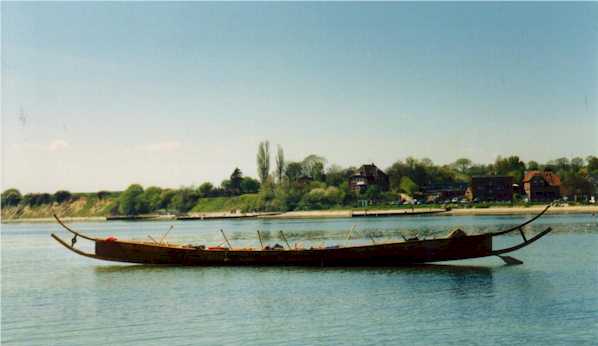Trials in May 2001
 On Aabenraa fjord, May 11 2001. |
 On Aabenraa fjord, May 11 2001. |
 At anchor at the Soenderborg Castle, May 12 2001. |
On the 11th to 13th of May a series of tests with Tilia was performed. The tests were co-ordinated by Max Vinner, Vikingeskisbhallen assisted by Rikke Johansen, Vikingeskibshallen. Otto Uldum (Centre for Maritime Archaeology at the National Museum of Denmark) conducted documentation with photos and video.
The main purpose of the tests was to check the crews’ possibility of sailing long distances with Tilia in order to get a better understanding of the see traffic in Scandinavia in the late Bronze age and early Iron age. As last year the crew was from the Dragon-boat-club Viking Team Copenhagen. They participated with 25 paddlers headed by team leader Søren Boisen.
As a preparation we had made 4 long paddles for rib 9 and 10 and we had reduced the weight of the ash wood paddles by making the shafts thinner. Finally we had sharpened the paddle blades. We had produced and mounted new broad floorboards for better support for the feet of the paddlers. However these floorboards are not archeologically documented.
Friday at eight 20 members of the guild met at the shipyard in order to launch Tilia. At 8.45 Tilia was lying ready alongside the gangway in Dyvig. At 9.30 the dragon-boat crew arrived and the boarding started. Everyone was weighed along with gear and water. The weather was marvellous, almost no wind and sunshine. We sailed off at 11. The 25 dragon sailors, Max and Rikke plus Fenger and Chr. Møller from the guild together with the gear weighed 2450 kg; 700-800 kg more than the normal crew weight.
We went out through Stegsvig with 55 strokes per minute at a speed of 6 knots. Later the cadence dropped to 52 strokes per minute. On the north coast of Barsø we went ashore for lunch. Later we continued according to plan with a beautiful visit at Kalvø in Genner Bay. Tilia was back in Dyvig around 5 o’clock. We had baled out considerably on the way. The crew didn’t seem exhausted
On Saturday the crew arrived at 10 and boarded. This time we sailed south through Als Fjord and onwards through Alssund. Vi went ashore just south of Sønderbog Castle in a small sand bay. On the way we conducted some tests where half of the crew rested whilst the other half paddled. The speed was only reduced by 15% (Theoretically it should be 22%).
At 14.30 we headed back north. The cadence was 52 strokes per minute. On this trip we tested two new methods for resting.1. One rib rested for 5 minutes, then the next rib and so on. This meant that the members of the crew rested for 5 minutes and the paddled for 45 minutes. The reduction of speed lie within the measurement uncertainty.
2. Rib 10 and 5 rested for 3 minutes, then the time of rest passed to rib 9 and 4 and so on. The crewmembers then paddled 12 minutes and rested 3 minutes. This method reduced the speed with 6%, which is consistent with the theory
The paddlers preferred the last method and it can be recommended for long distance sailings.
The distance from Sønderborg Castle to the bottom of Dyvig (11.5 nautical miles) was sailed in 2 hours and 15 minutes giving an average speed of more than 5 knots.
On a day in June in prehistoric time with a calm see a similar boat on its way to summer solstitial feast in Tanum could sail from the eastern mouth of Limfjorden south of Læsø to Sweden in 12 hours using resting sequence 2. In order to finance the trip they could have carried along 2-300 kg of bronze and flint axes.
(By the way the distance corresponds to the distance around Als, 55 nautical miles).